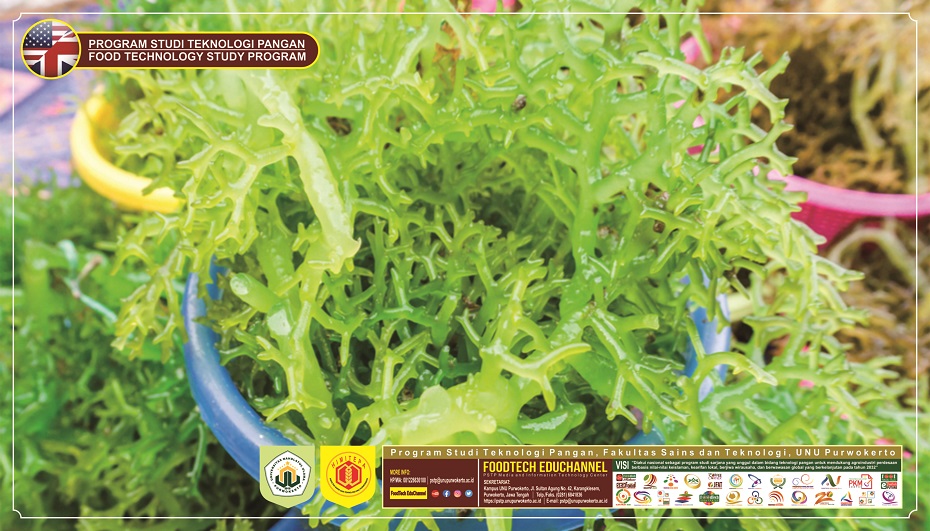
Ingredient- Food Technology: Seaweeds, International Class Ingridients
e-Foodtech Future – Seaweed has the opportunity to continue to be developed both as raw materials and food additives. Indonesia with a large coastal area is one of the largest producers of seaweed, after Chile for Gracilaria sp. and after the Philippines for Euchema sp.,. The two types of seaweed are the mainstay of Indonesia: Gracilaria sp. is the raw material for the manufacture of agar, while Euchema sp. commonly developed into carrageenan, which is a food ingredient for stabilizer, thickener, and gelling agent.
Seaweed is a marine plant that has the potential as a source of food and medicine. This plant contains polysaccharides which are widely used as food ingredients. Seaweed is also rich in compounds that are beneficial to health, including pigments produced by red seaweed (Rhodophyceae), green seaweed (Chlorophyceae), and brown seaweed (Phaeophyceae). Each type of seaweed has a specific pigment with a different composition. Several research results indicate that the content and composition of seaweed pigments are found in the types of Kappaphycus alvarezii, Caulerpa sp., and Sargassum sp. In Kappaphycus alvarezii, there are several types of pigments, namely carotene (0.947%), chlorophyll derivatives (16.418%), chlorophyll a (74.920%), xanthophyll (7.715%). Caulerpa sp. contains carotene (0.294%), chlorophyll derivatives (18.731%), chlorophyll a (26.817%), chlorophyll b (12.906%), and xanthophyll (29.758%). Sargassum sp. contains b-carotene (1.49%), fucoxanthin (20.95%), chlorophyll a (52.82%), chlorophyll c (1.05%), chlorophyll derivatives (15.23%), and xanthophyll (8, 46%).
The use of seaweed as food has been carried out since ancient times, even seaweed is allegedly consumed since ancient times. Seaweed is generally edible. This marine plant is rich in polysaccharides, essential minerals, vitamins and protein, low in calories and low in fat. The polysaccharide content in seaweed reaches 4-76% of its dry weight. There are about 56 types of minerals and trace minerals in seaweed. Mineral content in seaweed is 10-20 times higher than minerals in land plants. Seaweed also contains vitamins A, B, C, and D and vitamin E. Seaweed also contains vitamin B12, which is commonly found in animals. The protein content in seaweed reaches 10-40% while the fat content only ranges from 1-5% of the dry weight. The type of fat in seaweed is PUFA (polyunsaturated fatty acids), especially omega-3 and omega-6 fatty acids which are concentrated in the galactolipid fraction. Seaweed has been used traditionally by Asian people in the treatment of cancer, liver and thyroid; improve the body’s immune function; as anti-bacterial and anti-virus. The need for seaweed consumption in the daily menu is quite reasonable considering the various important substances and benefits to support and protect the health of the body.
Various studies show the potential of seaweed as an important food source. Not surprisingly, the world is currently booming eating seaweed. Various ways are done to include seaweed in the diet because the plant which is now dubbed as a “super food” is believed to be not only filling but also healthy for the body. Hopefully in a country known as one of the largest seaweed producers in the world, the trend of eating seaweed will also increase. Seaweed has the potential as a smart food solution to play a role in maintaining food stability, supporting health and improving people’s welfare. Thus Kavadya Syska, Coordinator of the Food Technology Study Program, Faculty of Science and Technology, University of Nahdlatul Ulama Purwokerto.
Sources: interviews and references analysis
Food Technology UNU Purwokerto: Creative, Innovative, Fantastic
Food Technology UNU Purwokerto: Developing Creative and Innovative Future
https://pstp.unupurwokerto.ac.id



